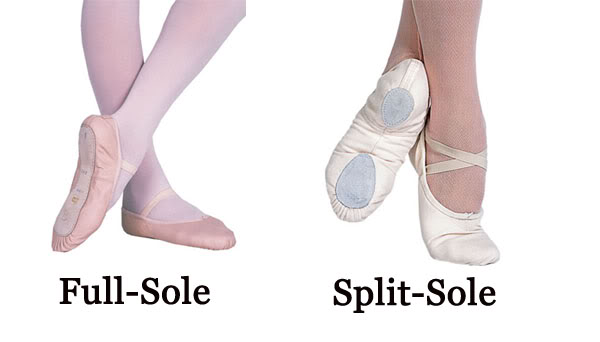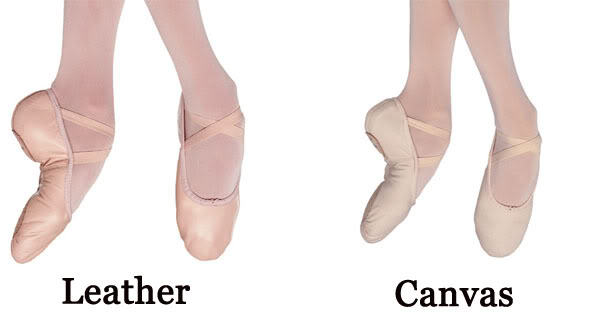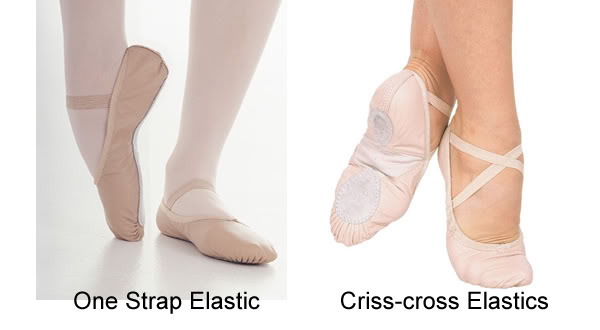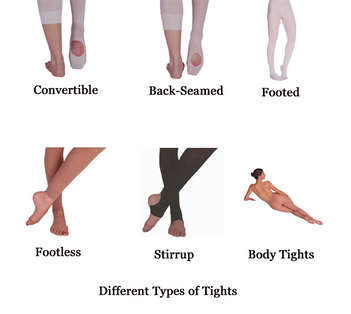Ballet Shoes/Slippers:
The minute you start ballet, you immediately start thinking that it will only be a matter of time before you are en pointe, and dancing in Swan Lake. Wait! Hold up! To get to pointe takes a LOT of time (read: years) and work. You most likely will not be dancing en pointe any time soon if you are a new dancer. So put away those pointe shoes dreams for at least a year or two. The only shoe that you’ll be dancing in will be a ballet slipper. Which is perfectly fine….as a beginner you’ll learn that ballet slippers are really all you need to learn and then hone your technique.
Once again the best way to find the perfect ballet slipper for you is to go to a store, get fitted, and try them on. When trying them on, do some releves and tendus...point your foot, move about in them...basically you want to get a feel for them on your foot.
The ballet slipper should fit your foot like a glove...not too tight or small, and not too loose or big. When standing up with your feet flat on the ground, you want your feet and toes to lay flat in the shoe. Don’t buy a ballet slipper if your toes are crunched up in them, or can’t lay flat at all. Ballet slippers stretch, but not that much. Also, do not buy ballet slippers with the intent to “grow into” them. This is a bad idea, since you don’t want to be tripping over the toes of your ballet slippers. Just buy them to fit your foot, it will be a better move in the long run.
Type of Slipper:
Ballet slippers come in different types and materials. There are also a whole bunch of different brands to choose from. Basically there are two different types of ballet slippers: full-sole and split-sole.
The “traditional” slipper was a full-sole, so called because the leather sole ran the length of the foot. Split-sole shoes are newer shoes, so called because there is half a sole under the heel of the foot, and half a sole under the ball of the foot. And there isn’t a leather sole under the arch of the foot. Full soles are considered “better” because they make the dancer really work the foot (ie: make it stronger) to see the arch of the foot. Split-soles allow the dancer to see the arch of the foot a lot easier. But what kind of shoe you want is really up to you.
The minute you start ballet, you immediately start thinking that it will only be a matter of time before you are en pointe, and dancing in Swan Lake. Wait! Hold up! To get to pointe takes a LOT of time (read: years) and work. You most likely will not be dancing en pointe any time soon if you are a new dancer. So put away those pointe shoes dreams for at least a year or two. The only shoe that you’ll be dancing in will be a ballet slipper. Which is perfectly fine….as a beginner you’ll learn that ballet slippers are really all you need to learn and then hone your technique.
Once again the best way to find the perfect ballet slipper for you is to go to a store, get fitted, and try them on. When trying them on, do some releves and tendus...point your foot, move about in them...basically you want to get a feel for them on your foot.
The ballet slipper should fit your foot like a glove...not too tight or small, and not too loose or big. When standing up with your feet flat on the ground, you want your feet and toes to lay flat in the shoe. Don’t buy a ballet slipper if your toes are crunched up in them, or can’t lay flat at all. Ballet slippers stretch, but not that much. Also, do not buy ballet slippers with the intent to “grow into” them. This is a bad idea, since you don’t want to be tripping over the toes of your ballet slippers. Just buy them to fit your foot, it will be a better move in the long run.
Type of Slipper:
Ballet slippers come in different types and materials. There are also a whole bunch of different brands to choose from. Basically there are two different types of ballet slippers: full-sole and split-sole.
The “traditional” slipper was a full-sole, so called because the leather sole ran the length of the foot. Split-sole shoes are newer shoes, so called because there is half a sole under the heel of the foot, and half a sole under the ball of the foot. And there isn’t a leather sole under the arch of the foot. Full soles are considered “better” because they make the dancer really work the foot (ie: make it stronger) to see the arch of the foot. Split-soles allow the dancer to see the arch of the foot a lot easier. But what kind of shoe you want is really up to you.
Materials:
Slippers also come in three different materials: Leather, Canvas, and Satin.
Leather and Canvas are the most popular; Satin is rarely used for class work…maybe more for recitals. What kind of material you want is also up to you.
Leather:
Leather is more a classic shoe material…it doesn’t stretch that much, and has a more smooth appearance.
Canvas:
Canvas is well, cloth, so it does stretch. You can wash canvas shoes, which you can’t do with leather. A note about canvas shoes: they may pinch for the first week or two of classes, but they do stretch out.
Slippers also come in three different materials: Leather, Canvas, and Satin.
Leather and Canvas are the most popular; Satin is rarely used for class work…maybe more for recitals. What kind of material you want is also up to you.
Leather:
Leather is more a classic shoe material…it doesn’t stretch that much, and has a more smooth appearance.
Canvas:
Canvas is well, cloth, so it does stretch. You can wash canvas shoes, which you can’t do with leather. A note about canvas shoes: they may pinch for the first week or two of classes, but they do stretch out.
Elastics:
Elastics keep your shoes on. Most slippers come with elastics so you can attach them yourself, or they have pre-attached elastics. Normally, you’ll have to do some sewing to attach the elastics. Get someone who either knows how to sew or learn to do it yourself, because sewing actually goes hand-in-hand with ballet dancing. Ballerinas are always sewing elastics or ribbons on their shoes, so it’s a handy thing to learn to do now. Anyway, back to the elastics. There are a few different ways to position the elastics on your feet.
One strap elastics: One strap, from one side of the shoe to the other, straight across.
Criss-crossed elastics: Form a cross over the instep of the foot, holding the shoe on better.





 RSS Feed
RSS Feed